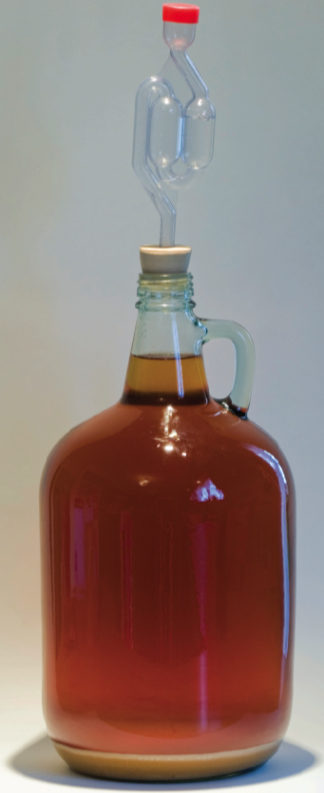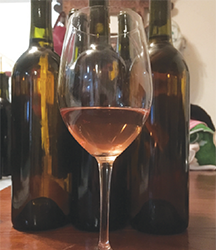 The running gag around our place is that you’ve heard of a microbrewery or microwinery? Well, we have a nanowinery.
The running gag around our place is that you’ve heard of a microbrewery or microwinery? Well, we have a nanowinery.
Our winery is so small (how small is it?) we have to step outside to change our minds. Okay, you’ve heard the jokes, but let’s be real. Not every home winemaker has the luxury of a full basement, or a large workshop, or any other decent-sized room with a sink, even temperatures and lots of shelving that can be dedicated to just making and aging wine. In fact, for a lot of folks, if you can get any dedicated space, at all, you’re doing well.
“I live in quite a small home in Philly,” said Joe McAteer, who also runs the Philadelphia Home Brew Club, a group that enjoys all kinds of fermentation activity, including wine, beer, cheese and even dried sausages. “Everything’s shared in this house.” he says, “I have two little girls.”
And while his biggest challenge is finding time when his daughters are otherwise occupied so that he can get some winemaking done, he doesn’t work with fresh grapes simply because he doesn’t have the space to put them, even in his basement, where he’s building some wine racks for extra storage capacity.
“I would really like to,” he said about working with fresh grapes rather than kits. “But it’s the lack of space and the additional equipment, and that’s not cheap at all. You’re talking about a wine press. It would be nice to get the barrel, and that is a lot of space.”
Small kits are extremely convenient for apartment dwellers, since a bucket and a carboy don’t take up that much space. But finding space for the work of winemaking can be a little challenging, whether it’s racking or bottling or even filtering. McAteer said that he pretty much takes over the kitchen when he’s working – possibly why he doesn’t want his young daughters around when he’s racking or bottling.
Then there’s the additional problem of ambition outstripping the space you have. The more wine you make, the more space you need to store it and the equipment. McAteer talked with awe about his friend’s basement, which is as big as McAteer’s house. The friend also has a separate space in the basement for aging wine, beer, cheese and sausages.
“One whole section dedicated to aging,” McAteer said wistfully.
Whether you simply want to make 50 gallons of one or two varieties or make as many different varieties as you can get grapes — our household record is 13 in one harvest season — finding enough space to house that barrel or all those carboys can be a challenge.
Our house, for example, was built in 1925, when life was simpler and people simply didn’t have quite so much stuff, and so there’s not a lot of storage here. We have a one-car detached garage, the back of which is dedicated to my husband’s winemaking operation. It’s expanded a bit since the days my daughter still lived with us and Michael had to share the garage with my office. Even then, I spent more than a couple harvest seasons with fermenters bubbling away in front of my desk. All those fumes made interviewing people really interesting.
Since I moved my office into my daughter’s room, we were able to give Michael some extra floor space, but not much. The winery is still barely 9 feet (~3 m) wide, not including the shelving, which is shared with all the boxes of books that we don’t have shelf space for in the house. The winery also includes a large metal chest that houses our media collection. Carboys are lined up in front of the shelves and on the small desk in the back, and under the desk and we did find room for a small wine fridge and a small chest freezer that Michael adapted for cold soaking. The front of the garage is mostly storage for everything else we need to store, although Michael managed to squeeze in a few extra fermenters last harvest season.
Home winemaker Kathryn Chalfan uses a crawl space under her home in Bellevue, Washington. Because the house backs up onto a hill, the section she uses is 8-feet (2.4-m) high, but it’s still barely
6 by 22 feet (1.8 x 6.7 m).
“We have a workbench by a daylight window,” she said. Plastic tarps cover some of the dirt piles, and there’s shelving and just enough room for a styrofoam hot box that’s 4 by 8 feet (1.2 x 2.4 m). She decided to use her crawl space by happy accident, when she had to install a drain to prevent flooding under the house as it was. Then one of her two winemaking partners asked if they could store some carboys in the space and she decided to finish it and use it as a winery.
“It’s thermally very stable,” she said about the small space. “We were in the garage, but I didn’t like having my car out of the garage.”
But because the space is tight in the crawl space, it does present a problem when she and her two partners try to work together.
“People have fallen on something,” she said. “One night after we got through with some major racking activity, we were tired.”
Carboys were stacked all over and Chalfan didn’t realize there was one right behind her.
“I backed up and I stumbled and I fell and I broke my fall with my hand, so I didn’t get sliced on my buns,” she said.
But she did have to go to the hospital to get her hand stitched up. They were able to rescue most of the wine, too.
Safety issues aside, storage is also a big issue in tiny wineries, whether it’s equipment or aging wines.
“Storage is an issue any time I’m making wine,” said Mark Wasserman, a home winemaker in the process of going professional. He recently moved to a home with a two-car garage, but prior to that, was making wine in a rented condo in Los Angeles that only had a one-car garage.
“We’re supposed to park one car in the garage, with one on the street,” he said about his current home. “But I end up taking over the garage and not parking any cars in the garage.”
His space situation was even tighter in the condominium, where he often ended up leaving the car out of the garage and simply putting all his winemaking gear in the middle.
Laura Arbacus, owner of Arbor Wine & Beer Making Supplies in Islip, New York, makes wine at home in her apartment. And while she says that you don’t need as much space as you think to make wine, you do sometimes have to be a little creative about where to put stuff. She suggests housing a carboy inside a fermenting bucket, with the rest of your testing equipment and tubing neatly tucked inside to make a little caddy.
Arbacus insisted that the need for a large amount of space is a misconception. With some creativity and especially if you’re using a kit, winemaking need not take up more space than a fermenting bucket does. That being said, she said that if you’re going to make more than 6 gallons (23 L) of wine at a time, whether from fresh grapes or a kit, you’re going to have to find room for multiple carboys.
“I started making them part of my decoration in my apartment,” she said about the multiple carboys with airlock scattered about her place. “I store them under my coffee table, next to my kitchen counter, on my kitchen counter.”
She also stores empty bottles in the cases they came in, stacked one on top of each other. For storing her wine, she has several small wine racks that people have given her over the years scattered around her place, in which she keeps filled bottles. She also puts filled wine bottles back into the case they came in, then stacks the cases.
“Bottling, that is a bit of a pain in the neck,” she conceded.
We also re-use almost all of our bottles, filling in for those bottles we give away with commercial bottles that we sanitize and re-use after drinking the contents. It does make storage interesting, especially with cases stacked everywhere. But Michael has cut down a couple pallets to make putting the cases of aging wine in the two-foot high crawl space under our house – probably our best option for temperature control, as well, in our Southern California heat.
If you own your home, it’s a lot easier to install shelving in a closet or garage, but those who rent can’t always. Renters also face another concern – spillage and the possibility of wine stains causing them to lose their cleaning deposit.
“I was worried about the heat, worried about spilling on the floor, worried about the smell, worried that I could legally do it or not,” Wasserman said about his prior rented home, adding that he wasn’t sure his landlord would be okay with winemaking. “But, basically, I did it for three years and I made sure to clean up after I was done and when I left, I left it clean.”
McAteer owns his house, but still doesn’t want stains all over his home. He said he bottles and racks in his kitchen, where there’s tile, and puts a towel down to catch spills. Arbacus uses plastic carboys and carboy handles to prevent spillage from a shattering carboy. There are still dark stains on our living room floor from the last time a carboy broke during malolactic fermentation.
Good organization is also key to keeping a small space workable.
“It really is more efficient to have that organization,” Wasserman said, adding that in his current space, he has shelving and “a home for everything.”
“You plan out your day and make sure you have everything ahead of time,” said McAteer. “It’s really important to be sure you have everything ahead of time and make sure it’s sanitized ahead of time.”
Our winery is probably one of the best organized spaces on the property, except for our kitchen. It makes moving around a small space easier, as well.
And some operations simply have to be done elsewhere. Chalfon may do the actual racking in her crawl space, but one of her group is usually running carboys back and forth between the garage and the kitchen to clean them. Michael will often bottle in the kitchen. Grapes are pressed on the patio (we are blessed with a good-sized yard). And fermenters go wherever there is sufficient shade, preferably the front section of the garage, but sometimes the western side of the house (which gets very little sun thanks to neighboring trees) gets a line up of fermenters.
Still, some people, like McAteer, find it hard to make room for even a bucket or a carboy and may decide to find other options. Working with friends or a wine club can help a lot, even if you do most of the work at home. Chalfan belongs to a club and says that she doesn’t need to store a lot of the heavier equipment because she checks out presses and other such equipment from the club’s stores. McAteer is going to join a group of friends who all work together each spring and fall on a single large load of about 600 pounds of grapes.
“If you’re going to put in the effort you may as well make a lot of it,” McAteer said. “If you have a lot of people, then everybody gets 10 cases of wine.”
Another option is to go to a U-Vint or shop that specializes in providing the space and equipment to make wine, such as The Bacchus Winemaking Club, in Toms River, New Jersey.
“Essentially, we keep the mess out of your house,” said Shawn Hatton, general manager of the club.
But whether you ferment in a closet, or as we do, store your wine press on your coffee table as part of your décor, you can make wine in tight spaces. It just takes a little creativity and a lot of passion.
“If it’s a passion, you do whatever it takes,” Arbacus said of the predicament. “You make the space.”
You make the space even if it means seven carboys lined up in the living room so that they can finish malolactic fermentation. Or stepping around a hot box in a crawl space. Or a tiny space at the back of a garage. Because it’s worth it.






